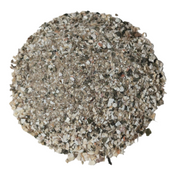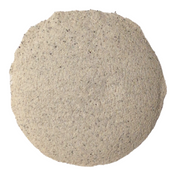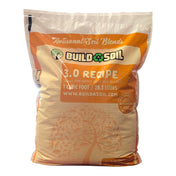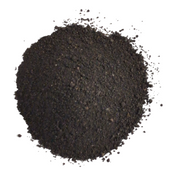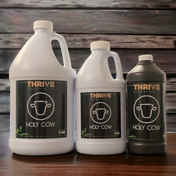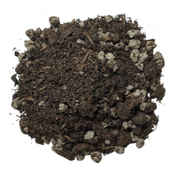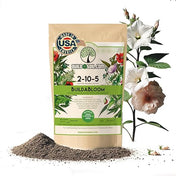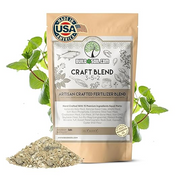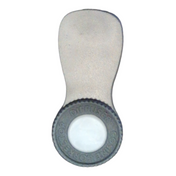Article from www.BioAg.com
|
Terminology of Humus-related Materials Humus--product resulting from decay of organic matter. Contains both humic and non-humic material. Humin--the alkali-insoluble fraction of leonardite. (The usage of this term does not correspond exactly with the usage by other workers.) . Humic substances--(plural) the collective name for the acid radicals found in humic matter. Typically separated from humic matter by alkaline extraction. Humic acid--(singular) the acid radical found in humic matter which is soluble in alkali but insoluble in acid, methyl ethyl ketone, and methyl alcohol. Humate--the salts of humic acids, collectively, or the salts of humic acid specifically. (The usage must be determined from the context.) Fulvic acid--the acid radical found in humic matter which is soluble in alkali, acid, methyl ethyl ketone, and methyl alcohol. Fulvates--the salts of fulvic acid. Leonardite--a soft brown coal-like deposit usually found in conjunction with deposits of lignite. Lignite--a type of soft coal. |
|
WHY ARE HUMATES IMPORTANT? Humates are considered commercially available forms of humic matter for use in agriculture, environmental, industrial, livestock and human wellbeing. Humates are in essence the salts of humic and fulvic acids. Humic compounds make up the bulk of organic matter in the World’s soils. Through millions of years compaction of plant and animal material, this material can be found Worldwide. Humic matter comes from a variety of sources including aquatic environments, geologic deposits and wetlands. Humic matter is also created from agricultural, industrial and municipal activities. |
Humates have been used in agriculture for many years, possibly thousands of years by early corn, squash and bean farmers in the Southwest U.S. In other countries, humic and fulvic acid use has been ongoing for many years with continual dollars put into research. However, In the U.S. there has been much misinformation regarding the use of humates, unintentionally spread by suppliers, distributors and marketers who are not scientists and who do not understand the humate research available (this is also due to lack of uniform testing, which we will go into later). Only in the last decade or so have we even understood how humates work. We now talk of an auxin-like response, not really knowing what causes it. It was never realized how effective humate was at very low application rates and how much soil change it can effect in a short time. Stimulation of biomass production at the bottom of the food chain is a part of the benefit of humates. Release of essential minerals from the soil for plant uptake is part of this process. |
Humic acids are crucial to life on earth and when they become depleted via oxidation or deactivated by sodium or aluminum, soil problems develop and can cause negative effects all the way up the food chain. Conditions of soil depletion resulting in low yield and/or susceptibility to diseases and pests have resulted in devastating effects for many civilizations of the past. Once humus (organic matter) is depleted, trace element availability along with phosphorus and calcium availability starts to decline. Anthropologists have observed this in many ancient civilizations. Human skeletons have shown the effects of deficiencies such as dental problems, osteoporosis and bone degeneration possibly resulting in many dying at young ages. When zinc is depleted learning ability is lost in the population along with fertility, and that is the end of that civilization. Analyzing the bone of the “mound builder” civilization of the U.S. Midwest has proved this. Bones found at the bottom of the mounds were in good health, whereas those found towards the top of the burials (or the end of the mound builders civilization) teeth and bone problems were very apparent through analysis of low-level zinc, calcium and phosphorus mineral content. Therefore, we can learn about mistakes of past civilizations concerning the need for improving agricultural soils through use of humate product, but are we doing enough in this country to reduce this problem? Other countries of the world are becoming more and more interested in humates, have completed large-scale research projects in many areas of humic use and have incorporated use of humates into their agricultural practices with much success. |
|
UNDERSTANDING THE DIFFERENCE
Various forms of raw humus and humates exist including those produced by composting, industrial by-products and those created during ancient geological events. However, for the purpose of using humates and derivatives including humic and fulvic acids, we will provide a brief overview of what you, the buyer of products, should understand if you want the best product for your money. When shopping around, it is in your best interest to know where a company sources their raw materials, processing methods, their scientific knowledge of the products and scientific research documents to back their claims. We encourage you to explore this and remember that price is not the most important factor when deciding on a product. There's a lot of junk out there so buyer beware!
BioAg starts with high quality humate material, rich in humic & fulvic!
|
Leonardite, coal or fossilized peat? Why is this important to distinguish? Bottom line is the bioactivity of the final product (humic and fulvic acid products). Analysis of various forms of humates from different sources have been conducted. Results show that BioAg's material contains 12% bioactive fulvic acid based ore whereas true Leonardite contains approximately 8% fulvic acid and high humic (up to 80%). However, unlike many claim, bioactivity is low...this form of humate material is great for drilling mud, not for bioactive products. |
|
2. Form, molecular weight and biological activity |
|
3. The Bottom Line & Results? This is an economic issue, boiled down to how much humic acid is one getting per dollar and what is the cellular stimulation level? Consider the fact that the more concentrated a humate product the cheaper it is to transport and apply. Therefore, the most concentrated source is the best buy due to transportation costs alone. Let's take a look at raw humate (before it's solublized and concentrated). A high-grade raw humate might be very effective at raising the yield by 20% or more with just 50lbs per acre of a 70-80% humic acid material. A humate of 34% humic requires 250-300# per acre of raw material to do the same job. What is the price, what is a pound of humic acid delivered going to be with current freight rates? Get your calculator out! A company claims to have the highest guaranteed humic acid available at 35% humic acids, 35% carbon and 35% organic matter. Is this the highest guaranteed humic material when another company has a product guaranteed at 80% humic acid and one in Washington State has one guaranteed at 70%? Is this misinformation? Consider the standard source of humic acid provided by many suppliers and their distributors-Leonardite, which contains over 80% humic acids. On the surface, this would seem to be the highest. However, this is not the most effective unless it is made into a soluble form where it becomes effective at low rate and the humic acids of the soluble powder can be over 80%. It is also low in the fulvic portion, the bioactive portion. These claims are often misleading, and not the fault of any one company, but a result of lack of testing standardization in our industry. Humates are valuable products, and until our industry can agree on some forms of standardization, only deal with companies with a track record and a proven high-grade product. Shipping sand doesn't make sense! |
|
Beware What you should know: toxic forms of humic substances are being supplied by some companies and their distributors.Click Here or on the image for details.
|
|





